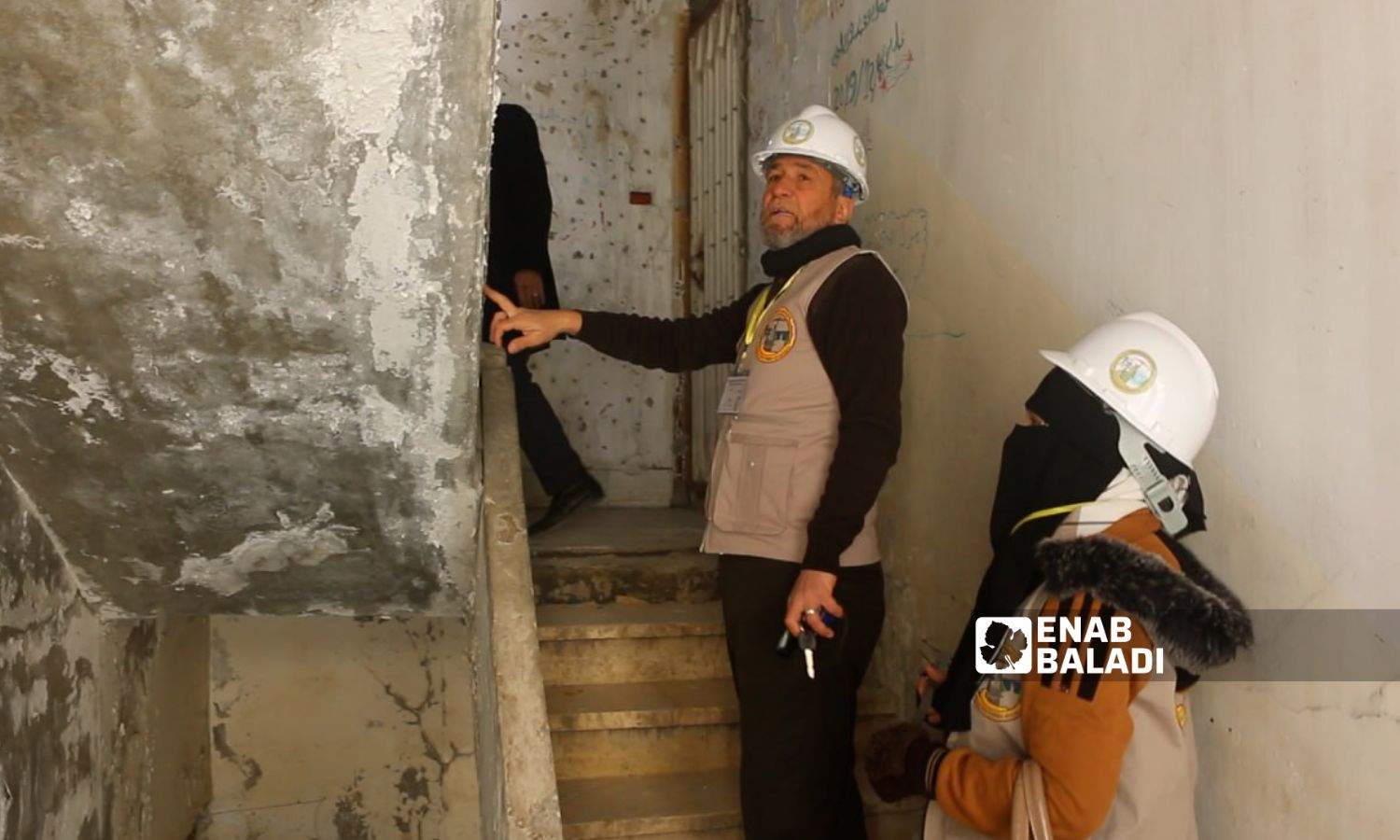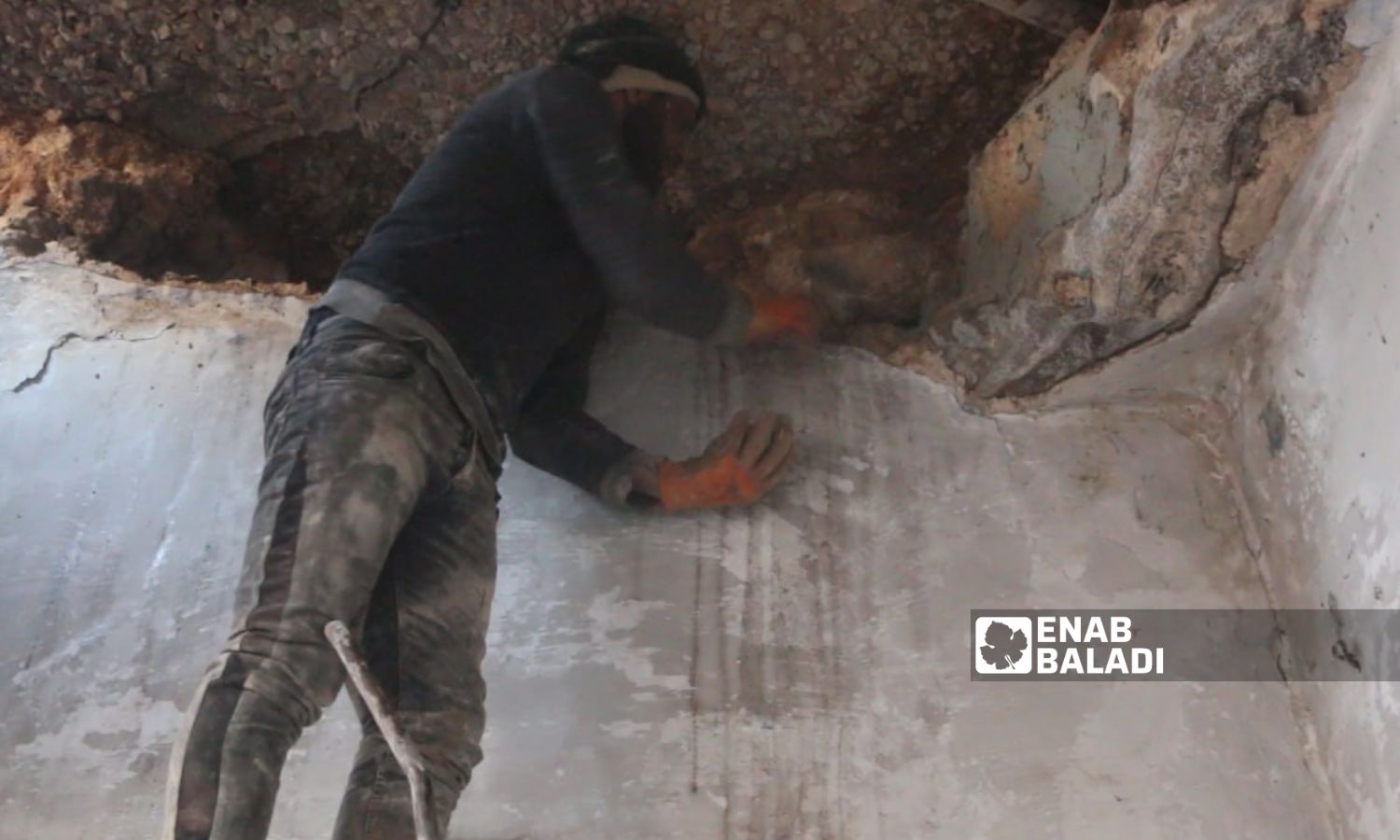



Enab Baladi – Anas al-Khouli
“It was a very cold and rainy night. I did not know how I was able to get my family out of the house the moment the earthquake occurred, just at the pre-dawn of February 6, so that we would run to the car and sit in it until the morning.”
This is how Mahmoud al-Faisal, a resident of the town of al-Dana in the northwestern Idlib region, with his family of seven people, survived the devastating earthquake that claimed tens of thousands of lives in Syria and Turkey.
According to what he told Enab Baladi, al-Faisal and his family spent the first hours of the earthquake in their car, and within the first hours of the morning, the man returned to his house to check on its situation, only to find that its walls had severely cracked, and it was about to fall.
Al-Faisal says that most of the residential buildings near his home in al-Dana are cracked and about to fall as a result of the earthquake.
More than two weeks ago, the man did not return to his home, like many of his neighbors residing in most of the earthquake-affected areas in northwestern Syria, in order to avoid the danger of returning, with the recurrence of aftershocks during the first days of the earthquake, which caused the collapse of cracked buildings.
Abdullah Samman, 41, an IDP from Daraa, sold all his properties in southern Syria to buy a house in Sarmada to house his family, he told Enab Baladi. However, the earthquake caused the collapse of one side of the building that includes his house where he resides, while the other side cracked, forcing residents to shelter in the makeshift camps.
The damage caused by the earthquake in northwestern Syria varied between the complete collapse of buildings, partial collapse, and cracks in the walls and foundations of many buildings, but all of these buildings are no longer habitable, according to what their owners said.
The owners of these buildings and apartments live in shelters designated for those affected by the earthquake in Idlib governorate, without any solutions on the horizon indicating their soon return to their homes.
The devastating earthquake displaced thousands of Syrian families in northern Syria, prompting many of them to flee towards camps and shelters, while a number of them chose to stay with their friends and relatives in their tents, which are considered safe against the earthquake.
Salem al-Meree, 48, displaced, whose house in the Harem area was completely destroyed, told Enab Baladi, “We thank God that we got out safely, but I feel sad about the loss of years of hard work in building my house, which was destroyed.”
Al-Meree said that in the early days of the earthquake, he witnessed many painful situations because of the fact that families were left with sorrow next to their demolished homes, and dozens of families were sleeping in the open without any place to shelter themselves.
Mahmoud Hallaq, a man in his fifties residing in the countryside of Idlib, told Enab Baladi that from the first hours, he began to communicate with relatives, friends, and acquaintances in the various areas that were subjected to severe earthquakes, then he was transferred with a team of young men from the area who left damaged houses safely to the city of Idlib to search for places to house them.
Hallaq transported more than 200 families from various regions of northern Syria towards the villages of Kafriya and al-Foua, towards their relatives and friends, while many families were distributed in the city of Idlib and some nearby villages.
The official spokesperson for the Idlib City Council, Firas Alloush, told Enab Baladi that the city alone included four new temporary shelters: the “al-Noor Tourist” complex, the “al-Mashtal” park, the “Shuaib” camp, and the University neighborhood (City Rose), in addition to setting up many camps and shelters in various regions of northern Syria, pointing to the absence of accurate statistics on the number of families displaced by the earthquake.

A residential building that was damaged as a result of the earthquake in Idlib – February 16, 2023 (Enab Baladi / Anas al-Khouli)
The head of the Public Relations and Media Committee of the Engineers Association in Idlib, Eng. Malek Haj Ali told Enab Baladi that the association, in partnership with the Ministry of Local Administration in the Syrian Salvation Government (SSG), formed a cell to manage the crisis since the first day of the earthquake, as a result of which nearly 30 engineering committees were formed in eight regions in the north.
The committees were divided into sub-committees and central ones, as the first division studies the conditions of the buildings, and in the event of deciding to demolish, the second division examines the building again and takes the decision, says Haj Ali.
The committees also prepare daily reports on their rounds, as at the end of their work, a comprehensive report will be prepared that includes the reasons for the fall of the buildings and the number of buildings that are completely or partially destroyed and badly damaged, which must be demolished.
Engineer Saeed al-Ashqar, advisor to the Minister of Local Administration in the Salvation Government, told Enab Baladi that the Ministry had initiated the formation of emergency response committees, including experienced engineers, to inspect the places damaged by the earthquake, in addition to the places adjacent to these buildings.
According to al-Ashqar, these committees were formed of three engineers, and they work on sensory detection of cracked and falling buildings and organize technical reports according to the different cases of these buildings.
These committees will submit their reports periodically, and they will be relied upon in the restoration and consolidation operations, and a technical report will be organized for the damaged buildings that can be supported to be relied upon in the coming stages.
The engineer pointed out that the residents of these buildings were referred to the Ministry of Development and Humanitarian Affairs for an emergency response to meet their needs.
A few days after the earthquake, the Molham Volunteering Team, operating in northern Syria, launched the “We can” campaign with the aim of reconstructing the buildings damaged by the earthquake.
Abdullah al-Suwaid, a member of the Molham Volunteering Team, told Enab Baladi that the goal of the campaign is to build alternative residential homes for the ones that were completely destroyed, which creates the need for a huge amount to secure homes for many families displaced by the earthquake.
Concerned institutions estimated the amount required to rebuild what was destroyed by the earthquake in northern Syria at $100 million, according to a statement published by the Molham team at the time of announcing the campaign.
if you think the article contain wrong information or you have additional details Send Correction